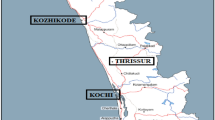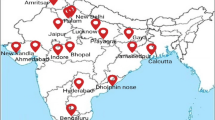Abstract
The optimal design and performance monitoring of wind farms depend on the precise assessment of spatial and temporal distribution of wind speed. The aim of this research is to investigate the appropriateness of nine popular probability distribution models (exponential, gamma, generalised extreme value, inverse Gaussian, Kumaraswamy, log-logistic, lognormal, Nakagami, and Weibull) for the assessment of wind speed distribution (WSD) at 10 sites situated at topographically distinct locations in Tamil Nadu, India, based on 39 years of data. The results suggest that a single distribution cannot produce best fit for all the stations. On an individual level, the generalised extreme value distribution provided the most suitable fit for majority of the stations, followed by the Kumaraswamy distribution. The Kumaraswamy distribution has performed well even if the WSD of the station is negatively skewed. Hence, based on the ranking and performance consistency, the Kumaraswamy distribution can be preferred irrespective of the topographical heterogeneity of the stations.











Similar content being viewed by others
Availability of data and materials
All data generated or analysed during this study are included in this published article.
References
Akgul FG, Senoglu B, Arslan T (2016) An alternative distribution to Weibull for modeling the wind speed data: inverse Weibull distribution. Energy Convers Manag 114:234–240. https://doi.org/10.1016/j.enconman.2016.02.026
Alavi O, Mohammadi K, Mostafaeipour A (2016) Evaluating the suitability of wind speed probability distribution models: a case of study of east and southeast parts of Iran. Energy Convers Manag 119:101–108. https://doi.org/10.1016/j.enconman.2016.04.039
Aries N, Boudia SM, Ounis H (2018) Deep assessment of wind speed distribution models: A case study of four sites in Algeria. Energy Convers Manag 155:78–90
Arslan G, Oncel SY (2017) Parameter estimation of some Kumaraswamy-G type distribution. Math Sci 11:131–138
Arslan T, Acitas S, Senoglu B (2017) Generalised Lindley and power Lindley distributions for modeling the wind speed data. Energy Convers Manag 152:300–311. https://doi.org/10.1016/j.enconman.2017.08.017
Ayodele TR, Jimoh AA, Munda JL, Agee JT (2012) Wind distribution and capacity factor estimation for wind turbines in the coastal region of South Africa. Energy Convers Manag 64:614–625. https://doi.org/10.1016/j.enconman.2012.06.007
Bagci K, Arslan T, Celik E (2021) Inverted Kumaraswamy distribution for modeling the wind speed data: Lake Van, Turkey. Renew Sust Energ Rev 135:110110. https://doi.org/10.1016/j.rser.2020.110110
Bagiorgas HS, Mihalakakou G, Rehman S, Al-Hadhrami LM (2011) Weibull parameters estimation using four different methods and most energy carrying wind speed analysis. Int J Green Energy 8(5):529–554. https://doi.org/10.1080/15435075.2011.588767
Bagiorgas HS, Mihalakakou G, Rehman S, Al-Hadhrami LM (2012) Wind power potential assessment for seven buoys data collection stations in Aegean Sea using Weibull distribution function. J Renew Sustain Energy 4(1):013119–013134. https://doi.org/10.1063/1.3688030
Bagiorgas HS, Mihalakakou G, Rehman S, Al-Hadhrami LM (2016) Wind power potential assessment for three buoys data collection stations in Ionian Sea using Weibull distribution function. Int J Green Energy 13(7):703–714. https://doi.org/10.1080/15435075.2014.896258
Bardsley WE (1980) Note on the use of the inverse Gaussian distribution for wind energy applications. J Appl Meteorol 19:1126–1130. https://doi.org/10.1175/1520-0450(1980)019<1126:NOTUOT>2.0.CO;2
Baseer MA, Meyer JP, Rehman S, Alam Md M (2017) Wind power characteristics of seven data collection sites in Jubail, Saudi Arabia using Weibull parameters. Renew Energy 102:35–49. https://doi.org/10.1016/j.renene.2016.10.040
Bassyouni M, Saud AG, Javaid U, Awais M, Rehman S, Abdel-Hamid SMS, Abdel-Aziz MH, Abouel-Kasem A, Shafeek H (2015) Assessment and analysis of wind power resource using Weibull parameters. Energy Explor Exploit 33(1):105–122. https://doi.org/10.1260/0144-5987.33.1.105
Bidaoui H, Abbassi EI, Bouardi EA, Darcherif A (2019) Wind speed data analysis using weibull and Rayleigh distribution functions, case study: five cities Northern Morocco. Procedia Manuf 32:786–793
Carrasco JMF, Ortega EMM, Paula GA (2008) Log-modified Weibull regression models with censored data: sensitivities and residual analysis. Comput Stat Data Anal 52:4021–4039
Chiodo E, Falco PD (2016) Inverse Burr distribution for extreme wind speed prediction: genesis, identification and estimation. Electr Power Syst Res 141:549–561. https://doi.org/10.1016/j.epsr.2016.08.028
Chiodo E, Lauria D (2009) Analytical study of different probability distributions for wind speed related to power statistics. In: IEEE Int. conf. on clean electrical power
Chutcher HL, Baer L (1962) Computations from elliptical wind distribution statistics. J Appl Meteorol 14:1512–1520. https://doi.org/10.1175/1520-0450(1962)001<0522:CFEWDS>2.0.CO;2
Fletcher SC, Ponnambalam K (1996) Estimation of reservoir yield and storage distribution using moments analysis. J Hydrol 182:259–275
Ganji A, Ponnambalam K, Khalili D, Karamouz M (2006) Grain yield reliability analysis with crop water demand uncertainty. Stochastic Environ Risk Assess 20:259–277. https://doi.org/10.1007/s00477-005-0020-7
Garcia A, Torres JL, Prieto E, Francisco AD (1998) Fitting wind speed distributions: a case study. Sol Energy 62:139–144. https://doi.org/10.1016/S0038-092X(97)00116-3
Ghosh I, Hamedani GG (2017) Gamma-Kumaraswamy distribution in reliability analysis: properties and applications. In: Advances in Statistical methodologies and their application to real problems, edited by Hokimoto T, 6:123–142
Jones MC (2009) Kumaraswamy’s distribution: a beta type distribution with tractability advantages. Stat Methodol 6:70–81
Kang D, Ko K, Huh J (2015) Determination of extreme wind values using the Gumbel distribution. Energy 86:51–58. https://doi.org/10.1016/j.energy.2015.03.126
Kantar YM, Llhan U, Arik I, Yenilmez I (2018) Wind speed analysis using the extended generalised Lindley distribution. Renew Energy 118:1024–1030. https://doi.org/10.1016/j.renene.2017.09.053
Kollu R, Rayapudi SR, Narasimham SVL, Pakkurthi KM (2012) Mixture probability distribution functions to model wind speed distributions. Int J Energy Environ Eng 3:27. https://doi.org/10.1186/2251-6832-3-27
Kumaraswamy P (1980) Generalised probability density-function for double bounded random-processes. J Hydrol 46:79–88. https://doi.org/10.1016/0022-1694(80)90036-0
Lee C, Famoye F, Olumolade O (2007) Beta-Weibull distribution: some properties and applications to censored data. J Mod Appl Stat Methods 6(1):173–186
Lopez-Martinez FJ, Morales-Jimenez D, Martos-Naya E, Paris JF (2013) On the bivariate Nakagami-m cumulative distribution function: closed-form expression and applications. IEEE Trans Commun 61(4):1404–1414. https://doi.org/10.1109/TCOMM.2013.020412.120413
Mahmood FH, Resen AK, Khamees BA (2020) Wind characteristic analysis based on Weibull distribution of Al-Salman site, Iraq. Energy Rep 6(3):79–87
Manwell JF, McGowan JG, Rogers AL (2002) Wind energy explained: theory, design and application. John Wiley & Sons, Amherst
Masseran N, Razali AM, Ibrahim K (2012) An analysis of wind power density derived from several wind speed density functions: the regional assessment on wind power in Malaysia. Renew Sust Energ Rev 16(8):6476–6487. https://doi.org/10.1016/j.rser.2012.03.073
Mateos-Salvador F, Sadhukhan J, Campbell MG (2011) The normalised Kumaraswamy breakage function: a simple model for wheat roller milling. Powder Technol 208(1):144–157. https://doi.org/10.1016/j.powtec.2010.12.013
Meeker WQ, Escobar LA (1998) Statistical methods for reliability data. John Wiley & Sons
Mert I, Karakus C (2015) A statistical analysis of wind speed data using Burr, generalized gamma and Weibull distributions in Antakya, Turkey. Turk J Electr Eng Comput Sci 23(6):1571–1586. https://doi.org/10.3906/elk-1402-66
Mirhosseini M, Sharifi F, Sedaghat A (2011) Assessing the wind energy potential locations in province of Semnan in Iran. Renew Sust Energ Rev 15(1):449–459. https://doi.org/10.1016/j.rser.2010.09.029
Mohammadi K, Mostafaeipour A, Sedaghat A, Shamshirband S, Petkovic D (2017) Application and economic viability of wind turbine installation in Lutak, Iran. Environ Earth Sci 75:248. https://doi.org/10.1007/s12665-018-7996-z
Morgan EC, Lackner M, Vogel RM, Baise LG (2011) Probability distribution for offshore wind speed. Energy Convers Manag 52:15–26. https://doi.org/10.1016/j.enconman.2010.06.015
Mudholkar GS, Srivastava DK, Kollia GD (1996) A generalisation of the Weibull distribution with application to the analysis of survival data. J Am Stat Assoc 91:1575–1583
Nadrajah S, Kotz S (2005) On some recent modifications of Weibull distribution. IEEE Trans Reliab 54(4):561–562
Ouarda TBMJ, Charron C, Shin JY, Marpu PR, Al-Mandoos AH, Al-Tamimi MH, Ghedira H, Al Hosary TN (2015) Probability distributions of wind speed in the UAE. Energy Convers Manag 93:414–434. https://doi.org/10.1016/j.enconman.2015.01.036
Pishgar-Komleh SH, Keyhani A, Sefeedpari P (2015) Wind speed and power density analysis based on Weibull and Rayleigh distributions (a case study: Firouzkooh county of Iran). Renew Sust Energ Rev 42:313–322. https://doi.org/10.1016/j.rser.2014.10.028
Rehman S, Mahbub AM, Meyer JP, Al-Hadhrami LM (2012) Wind speed characteristics and resource assessment using Weibull parameters. Int J Green Energy 9:800–814. https://doi.org/10.1080/15435075.2011.641700
Safari B (2011) Modeling wind speed and wind power distributions in Rwanda. Renew Sust Energ Rev 15:925–935. https://doi.org/10.1016/j.rser.2010.11.001
Sanchez S, Ancheyta J, McCaffrey WC (2007) Comparison of probability distribution functions for fitting distillation curves of petroleum. Energy Fuel 21(5):2955–2963. https://doi.org/10.1021/ef070003y
Sarkar A, Singh S, Mitra D (2011) Wind climate modeling using Weibull and extreme value distribution. Int J Eng Sci Technol 3:100–103
Scerri E, Farrugia R (1996) Wind data evaluation in the Maltese Islands. Renew Energy 7(1):109–114. https://doi.org/10.1016/0960-1481(95)00097-6
Shoaib M, Siddiqui I, Rehman S, Saifur R, Khan S (2017) Speed Distribution Analysis based on Maximum Entropy Principle and Weibull Distribution Function. Environ Prog Sustain Energy 36(5):1480–1489. https://doi.org/10.1002/ep.12589
Shukla R, Trivedi M, Kumar M (2010) On the proficient use of GEV distribution: a case study of subtropical monsoon region in India. Ann Univ Tibiscus Comp Sci Ser 8(1):81–92
Singla N, Jain K, Sharma SK (2012) The beta generalized Weibull distribution: properties and applications. Reliab Eng Syst Saf 102:5–15
Soukissian T (2013) Use of multiparameter distributions for offshore wind speed modeling: The Johnson SB distribution. Appl Energy 111:982–1000. https://doi.org/10.1016/j.apenergy.2013.06.050
Sundar V, Subbiah K (1989) Application of double bounded probability density function for analysis of ocean waves. Ocean Eng 16(2):193–200. https://doi.org/10.1016/0029-8018(89)90005-X
Teimouri M, Hoseini SM, Nadarajah S (2013) Comparison of estimation methods for the Weibull distribution. Statistics 47(1):93–109. https://doi.org/10.1080/02331888.2011.559657
Weblink1-World wind Energy Association (WWEA) (2019) http://wwindea.org/information-2/information/ (Accessed on March 03, 2019)
Author information
Authors and Affiliations
Contributions
NN performed the simulation studies. MV compiled the introduction and conclusion sections. SR contributed in preparing the abstract and discussion sections. All authors read and approved the final revised manuscript.
Corresponding author
Ethics declarations
Ethics approval and consent to participate
Not applicable.
Consent for publication
Not applicable.
Competing interests
The authors declare no competing interests.
Additional information
Responsible Editor: Philippe Garrigues
Publisher’s note
Springer Nature remains neutral with regard to jurisdictional claims in published maps and institutional affiliations.
Appendix
Appendix
1. Exponential distribution
The PDF of the exponential distribution is determined using the following function (Masseran et al. 2012):
where λ is known as the scale parameter and λ can be calculated from the inverse of the mean wind speed:
2. Gamma distribution
The PDF of the gamma distribution is determined using the following function (Masseran et al. 2012):
where α is the shape parameter, and β is the scale parameter, and г is the Gamma function. The shape and scale parameters are calculated by following equations simultaneously:
where n is the number of samples and ψ is the di gamma function.
3. Generalised extreme value distribution
The PDF of the generalised extreme value distribution is defined as (Shukla et al. 2010):
For \( 1+\xi \left(\frac{v-\mu }{\sigma}\right)>0 \) and ξ ≠ 0.
4. Inverse Gaussian distribution
The PDF of the inverse Gaussian distribution is given by (Masseran et al. 2012):
where λ and μ are the shape and scale parameter, respectively. The parameters of the inverse Gaussian distribution is determined using the following expressions:
5. Log-Logistic distribution
The PDF of the log-logistic distribution is determined using the following functions (Meeker and Escobar 1998):
where μ and σ are log location and log scale parameters, respectively. The parameters of the log-logistic can be determined using the following equations simultaneously:
6. Lognormal distribution
The PDF of the lognormal distribution, with shape and scale parameters σ and μ, is obtained using the following function (Masseran et al. 2012):
7. Nakagami distribution
The PDF of the Nakagami distribution is defined by the following functions (Lopez-Martinez et al. 2013):
where Γis the gamma function and m and Ω indicate the shape and scale parameters calculated using the following expressions:
8. Weibull distribution
The PDF of the Weibull distribution is given by (Manwell et al. 2002):
where ν, k, and c are the wind speed, shape, and scale parameter, respectively.
The shape and scale parameters are determined as follows:
where vi is the wind speed at time step i (m/s) and n is the number of non-zero WD points.
Rights and permissions
About this article
Cite this article
Natarajan, N., Vasudevan, M. & Rehman, S. Evaluation of suitability of wind speed probability distribution models: a case study from Tamil Nadu, India. Environ Sci Pollut Res 29, 85855–85868 (2022). https://doi.org/10.1007/s11356-021-14315-5
Received:
Accepted:
Published:
Issue Date:
DOI: https://doi.org/10.1007/s11356-021-14315-5




